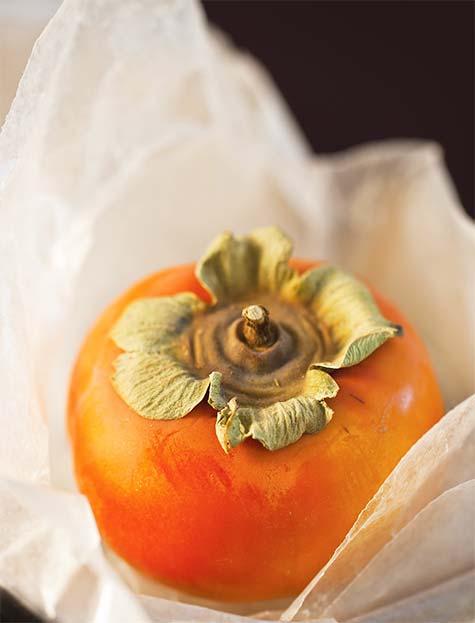
Photography by Chris Rov Costa
It’s easy to go through life having never enjoyed a persimmon. Resembling a reddish-orange tomato, this fruit is a seasonal fall delicacy that can escape most people’s attention if they’re not looking for them. To enjoy a Texas-grown persimmon, venture to a farmers market, a roadside stand or a pick-your-own orchard in midautumn when the fruit is at its peak of quality.
The effort may seem a little extreme, but those familiar with the fruit know just how rewarding the pursuit can be. Often described as candy-sweet, like a bowl full of dates drenched in honey with a hint of nuts, they have a unique flavor that’s enjoyable alone or as an ingredient in jams and jellies, baked goods, chutneys and sauces. As their scientific name Diospyros suggests—they are a fruit of the gods.
“The flavor of a persimmon is all on its own,” says grower Mary Lightsey of Lightsey Farms in Mexia. “There’s nothing to compare it to.”
Despite their high sugar content, they pack a powerful dose of nutrition. High in vitamins A and C, and loaded with manganese, calcium and other minerals, the fruit is especially beneficial for ocular health because of its high lutein and zeaxanthin content which protects eyes from ultraviolet light.
Almost all of the persimmon varieties available at the market have Asian origins. Often known as Japanese persimmons, most originated in China and were introduced into American cuisine over 100 years ago by immigrants living on the West Coast.
“We have people from Asian descent come out and picnic, pick their own fruit and just make a day of it each fall,” says Lightsey. “Church groups will come out, families will come out. It’s a main fruit in their culture, especially among Koreans.”
Persimmon varieties fall into two categories: astringent and nonastringent. Astringent types are loaded with tannins while they’re unripe, which makes them bitter enough to numb the tongue if eaten before they mature. As they ripen, the bitterness gives way to sugar, usually about the time of the first frost. The fruit becomes soft, like a bowl of jelly contained in a waxy, soft skin, similar to an overripe plum.
Hachiyas and Tamopans are the most widely available in the astringent category. Once picked, they must be eaten, cooked or stored within about a week or they will begin to rot. They may be picked just before they’re fully mature and ripened in a plastic bag, like pears and apples. Placing a banana in the bag is said to hasten the process. Of course, for the fullest flavor and nutrition, they’re best when picked ripe from the tree.
To enjoy the soft fruit, simply cut a hole in the top and spoon out the contents. The pulp can also be cooked and stored for adding later to pudding, muffins, bread and sauce recipes. High in pectin, it usually needs no extra thickeners for making it into a custard or fruit spread. Whole fruit can be frozen for months and eaten just as if the fruit were freshly picked. Frozen slices, peeled or with skins, are a great addition to smoothies.
Fuyu, Jiro, Gosho and Suruga are the most common non-astringent varieties. These can be eaten before they’re at their full ripeness because they have lower concentrations of tannins. With the texture of an apple, they’re known as the firm varieties. They can be eaten raw, skin and all, or used as a substitute for apples in pies, salads and even in salsa recipes.
America has its own native varieties. Wild persimmons were a food source for Native Americans and early colonists in the Eastern states, down the Atlantic coastline and throughout the Gulf region. Our word for the fruit comes from the Algonquian word pessemmins, which references how the fruit was dried for long-term storage, literally a dried fruit. All native persimmons are astringent and pack a strong, repulsive bitterness until they’re ripe.
In the southeastern regions of the U.S. and into most of East Texas, the native variety is a pale orange fruit, the size of a large berry or a small plum. Growing wild throughout northern Mexico, Central to West Texas and into southwest Oklahoma, the native species, known as Diospyros texana, produces a dark purple or black fruit that only measures about an inch across and tastes like a slightly overripe plum or prune.
Ripening as early as August, they’re delicious by the handful or when made into puddings, jams and jellies. Early Americans enjoyed spreading the ripe mashed fruit on cornbread.
Texas’ indigenous persimmon trees are gray and gnarled with peeling bark. They grow to a height of about eight feet, usually under the protective canopy of a larger oak and provide nutritious forage for native wildlife and feral hogs as well as hikers and survivalists. An easy tree to grow, they are hardy against most insects and diseases and are an attractive landscaping tree—one that comes with the added benefit of abundant fruit.
“Market demand focuses on the Asian varieties,” says Lightsey. “We sell to Central Market and Whole Foods Market, but a lot of people would rather come out to the country and pick their own.” Buyers should begin to look for the new harvest in October. A delicious indulgence, persimmons are a worthy addition to your shopping list
To enjoy a Texas-grown persimmon,
venture to a farmers market,
a roadside stand or a pick-your-own
orchard in mid-autumn when the fruit
is at its peak of quality.
MARSHALL HINSLEY is a writer and photographer who lives with his wife on a 40-acre farm south of Dallas. With a passion for growing sweet, vine-ripe specialty melons, he's also a sustainable farmer whose mission is to grow food crops in a way that improves the ecosystem and benefits wildlife as well.
- Marshall HInsleyhttps://www.edibledfw.com/author/mhinsley/
- Marshall HInsleyhttps://www.edibledfw.com/author/mhinsley/
- Marshall HInsleyhttps://www.edibledfw.com/author/mhinsley/
- Marshall HInsleyhttps://www.edibledfw.com/author/mhinsley/







